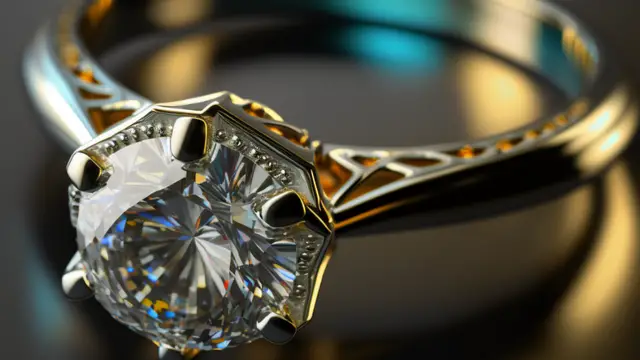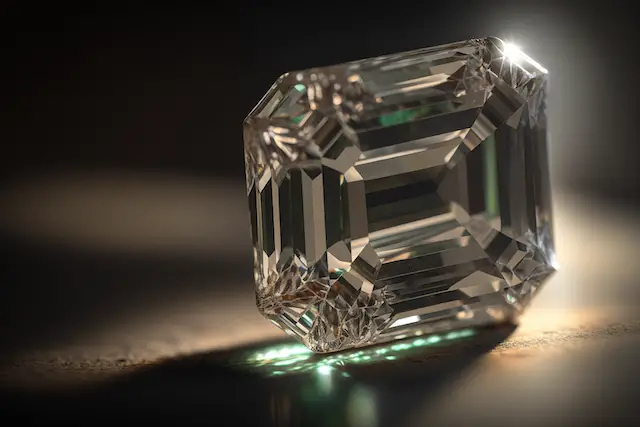Why Buy A Lab-Grown Diamond Engagement Ring? Pros & Cons
Lab-grown diamond engagement rings are an excellent investment for anyone seeking a sophisticated, timeless look without stretching your wallet too far.
Not only do they offer great value for money, but also amazing artistry and craftsmanship when creating bespoke designs that perfectly match your personal style.
These diamonds are ethically sourced from a controlled environment, so you can be sure of their superior quality, with fewer visible blemishes or inclusions than mined diamonds.
Their beautiful brilliance and dazzling sparkle also stand out compared to natural stones, adding a touch of luxe to any setting.
Investing in a lab-grown diamond engagement ring is an excellent choice for those wanting unique elegance at an affordable price!
What to Consider Before You Buy

Understanding Lab-Grown Diamonds
More and more couples are trending toward lab-grown diamonds for engagement rings. From Hollywood stars to millennials, they are becoming increasingly popular. But what exactly are lab-grown diamonds? And how do they compare to natural ones?
What Are Lab-Grown Diamonds?
Known as synthetic or man-made diamonds, these are real diamonds that have been created in a controlled environment rather than being mined from the Earth. Lab-created ones have the same chemical composition and physical properties as mined ones—they even look identical under a microscope!
They possess the same brilliance and sparkle as natural diamonds. Still, they can be more affordable because they don’t involve any of the costs associated with sourcing and mining a real one.
Additionally, since no mining is involved in producing lab-grown diamonds, they can be considered more ethical than traditionally mined.
How Are Lab-Grown Diamonds Made
Lab technology has come a long way in recent years.
Today, there are two main ways to create lab-grown diamonds:
- High Pressure/High Temperature (HPHT)
- Chemical Vapor Deposition (CVD)
HPHT is the most commonly used method of producing lab-grown diamonds. Carbon is exposed to very high temperatures (beyond 2,700 degrees Fahrenheit) and extreme pressure (approximately 1.5 million pounds per square inch) that mimic those found deep in the Earth’s crust. To initiate the process, a tiny diamond seed is placed atop the carbon.
CVD involves introducing carbon (a small diamond seed) into an oxygen-free environment (heated to over 1,400 Fahrenheit) and then coating it with layer by layer of carbon-rich gasses – namely methane and hydrogen (diamond material). Again a small diamond seed is used, akin to an HPHT one. After this process finishes, further treatments like heat or irradiation might be used in order to improve or change the color of the gemstone.
Differences Between Lab-Grown And Natural Diamonds
Lab-grown and natural ones may look identical to the untrained eye, but there are many differences in price tag, ethical implications, and physical characteristics.
Natural diamonds require energy-intensive mining operations, which can heavily damage the environment, while lab-grown production is much more efficient and doesn’t leave behind any environmental harm. This makes them a great choice for environmentally conscious individuals who don’t want to sacrifice quality or beauty when buying a diamond.
Lab-grown diamonds also tend to be far cheaper than natural stones due to their lack of excavation purposes.
On top of this, natural and lab-grown diamonds have distinct physical features that can only be seen under magnification or with specialized gemological testing equipment. Natural diamonds tend to include unique inclusions from their formation within the earth’s mantle, while lab-grown stones have fewer inclusions due to their creation process.
In addition, natural stones are slightly harder than lab-grown stones because of their formation process.
As for magnetism, lab-grown stones are slightly more magnetic than natural ones due to the presence of metallic elements used in their production.

Pros & Cons of Lab-Grown Diamonds
Pros: the pros of choosing a lab-grown diamond over a natural one include price savings (upward of 40%), ethical sourcing, fewer environmental impacts during production (no mining is required), and no required certification process (which means less paperwork!), and more creative freedom when designing an engagement ring with your chosen stone since you don’t have to worry about finding a large enough stone for your budget.
The quality of lab-grown stones tends to be very consistent since each stone is created under controlled conditions.
Variety – They come in all shapes and sizes, so you can find exactly what you’re looking for without compromising on quality or price.
Cons: The disadvantages of lab-grown diamonds are often apparent by the fact that they are not yet widely accepted as “real” diamonds. Society is used to natural diamonds, so lab-grown stones may be seen as less valuable or real than their natural counterparts.
Resale value – Since they’re still relatively unknown, it may be difficult to resell them at full value (labs do not buy back or recertify used stones).
Certification – Not all labs offer certification for lab-grown stones, so it may be difficult to prove authenticity if needed.
Rarity – Some people may prefer the exclusivity that comes with owning a natural diamond due to its rarity factor.
In addition difficulty in getting insurance coverage, a lack of recognition from gemstone organizations such as GIA, and lab-grown diamonds not having a “secondhand” market.
Pros and Cons of Lab-Grown Diamonds
| Pros | Cons |
|---|---|
| More affordable than natural diamonds | The perception that they are less valuable or “real” |
| Environmentally friendly and sustainable | Limited size and color options |
| Free from the ethical concerns of mining | Currently, a limited supply and high demand |
| Can be produced more quickly and consistently | Limited resale value |
| Can be used for industrial and technological purposes | Lack of historical and cultural significance |
| Physically and chemically identical to natural diamonds | Potential negative impact on the natural diamond industry |
| No conflict diamonds or blood diamonds | Some may view them as “artificial” or not as meaningful as natural diamonds |
| Less likely to have inclusions or other imperfections | Limited availability of certain cuts or styles |
| Offer a more modern and contemporary choice | Some may prefer the uniqueness and rarity of natural diamonds |
| Can be used to create more intricate and complex designs | Still a relatively new and untested industry |
Quality Considerations for Lab-Grown Diamonds
How do you grade a lab-grown diamond?
When it comes to grading a lab-grown diamond, the process is the same as with a mined diamond. The 4 Cs – cut, color, clarity, and carat weight – are used to determine the quality of a lab-grown diamond.
Are lab-grown diamonds real diamonds?
The answer is yes! When it comes to lab grown diamonds vs real, lab-grown diamonds are real diamonds created in a laboratory setting instead of in the earth. They possess the same chemical composition, crystal structure, and optical and physical properties as natural ones.
Grading and certification of lab-grown diamonds
Grading and certification are an important part of the diamond industry, as it helps to ensure that customers receive the highest quality diamonds possible.
The Gemological Institute of America (GIA) is one of the most trusted organizations in the world when it comes to grading and certifying diamonds. They use a system known as the 4Cs – color, clarity, cut, and carat weight – to evaluate a diamond’s quality.
The GIA also offers certification for lab-grown diamonds. This certification includes a full 4Cs assessment with a plotted clarity diagram, geographic origin information, and more. Other organizations such as the American Gemological Society (AGS), Hoge Raad voor Diamant (HRD), International Gemological Institute (IGI), and European Gemological Laboratory (EGL) also offer their own certifications for lab-grown diamonds.
Here is a quick guide summarizing their main features to help you gain insight into the five most renowned diamond grading laboratories worldwide.
| Laboratory | Grading Standards | Notable Features |
|---|---|---|
| GIA | Strict, consistent | Emphasizes color and clarity grading; laser inscriptions for added security |
| AGSL | Strict, consistent | Uses light performance grading; assigns cut grade on a 0-10 scale |
| IGI | Consistent | Grading system similar to GIA; offers additional services such as diamond identification and appraisal |
| HRD Antwerp | Consistent | Grading system similar to GIA; uses advanced technology for grading and identification |
| GCAL | Consistent | Provides additional information on light performance, polish, and symmetry; laser inscriptions for added security |

What to look for in terms of quality when buying a lab-grown diamond engagement ring
When it comes to buying a lab-grown diamond engagement ring, there are a few key factors to consider in terms of quality.
First, you’ll want to ensure the diamond is certified by an independent gemological laboratory. This will ensure that the diamond has been accurately graded and that its quality is consistent with what is stated on the certificate.
Additionally, you should look for diamonds with excellent cut, color, and clarity grades. A well-cut diamond will have maximum sparkle and brilliance, while a high color grade will ensure that your diamond looks as close to natural as possible.
Finally, you should look for diamonds with no visible inclusions or blemishes that could affect their beauty or durability.
What is the best carat size for a lab-grown diamond engagement ring?
It depends on your personal preference and budget. Generally, the average size of a lab-grown diamond engagement ring is 1.34 -1.5 carats, but they can range from 0.9 carats to 5 carats or more.
A 0.9-carat lab-grown diamond is popular because it is beautiful and affordable, while a 5-carat lab-grown diamond may be too hefty for some buyers. However, a 1.25-1.5-carat lab-grown diamond may be perfect for those looking for something in between.
Cost and Value
Pricing comparison between lab-grown and natural diamonds
Comparing lab-grown diamonds with those mined from Mother Nature can be tricky due to fluctuating prices, but one thing remains certain – lab-grown diamonds offer great value for money.
When looking at lab-grown and natural diamonds of the same quality and size, it’s generally accepted that the lab-grown option tends to cost significantly less than its natural equivalent. In fact, you can often save up to 40% or more by opting for a lab-grown diamond over a mined one!
| Carat Weight | Lab-Grown Diamond Price Range | Natural Diamond Price Range |
|---|---|---|
| 0.5 | $1,000 – $3,000 | $1,500 – $4,000 |
| 1 | $3,000 – $6,000 | $4,000 – $12,000 |
| 1.5 | $6,000 – $10,000 | $10,000 – $18,000 |
| 2 | $10,000 – $20,000 | $18,000 – $30,000 |
| 3 | $20,000 – $40,000 | $30,000 – $60,000 |
| 4 | $30,000 – $60,000 | $50,000 – $100,000 |
| 5 | $40,000 – $80,000 | $80,000 – $150,000 |
**Please bear in mind that the prices provided are merely approximations and could fluctuate depending on the diamond’s distinct qualities like diamond cut quality and color. Additionally, the prices may vary based on geographic location and retailer policies.
Shopping wisely is always a great idea, so take some time to explore different retailers and compare costs to get the highest quality for your money.
Determining value beyond just the cost
Beyond simply looking at the cost, plenty of other factors can influence the value of lab-grown diamonds. For example, their cut, clarity, color, and carat weight will all play a role in determining the ultimate price tag.
Additionally, certificates and grading reports from reputable sources can be taken into account to give an idea of quality. Lab-grown diamonds with distinct pricing ranges may also originate from certain parts of the world.
Finally, fluorescence is also important – when exposed to ultraviolet light, diamonds with less visible fluorescence tend to be more valuable than those with more visible fluorescence. These characteristics combine to create a dazzling option that’s great for stylish sparkle without breaking the bank.
Will a lab-grown diamond hold its value over time?
The lab-grown diamond industry is still relatively new and has yet to fully establish itself as a high-value commodity. That being said, lab-grown diamonds are becoming more popular and may be considered more valuable.
Ethical and Environmental Considerations of Lab-Grown Diamonds
The ethical concerns surrounding natural diamonds
Natural diamonds often come with ethical, environmental, and social concerns. Mining for them can be highly disruptive to fragile ecosystems, and the miners themselves often suffer from poverty, lack of access to basic services, and human rights violations.
Often times these gemstones are “blood diamonds” illegally sourced from war-torn countries or regions that are not committed to ethical labor practices. Furthermore, their origin can be difficult to trace as no reliable chain of custody exists.
By comparison, lab-grown diamonds offer an ethical alternative free from these issues as they are cultivated in a controlled laboratory environment with minimal environmental impact and no exploitation of vulnerable laborers.
How lab-grown diamonds are more ethical and environmentally friendly
Lab-grown diamonds offer an ethical and environmentally-friendly alternative to natural ones, as they are 100% conflict-free and ethically sourced.
Grown in a laboratory, these diamonds have no environmental impact during their production process and eliminate the need for deep sea or land dredging. Lab-grown diamonds also help reduce the emissions associated with traditional diamond mining and make it easier to track the origin of the stones from when they were first created in the lab.
This can be especially beneficial for those purchasing diamonds certified by reliable institutions. With lab-grown diamond rings, you can be sure you’re investing in an ethical and sustainable option with fewer hidden costs than conventional mined diamonds!
The importance of choosing an eco-friendly lab-grown diamond
Choosing an eco-friendly lab-grown diamond is an increasingly important decision. Not only do these diamonds provide ethical and sustainable alternatives to traditionally mined diamonds, but they also have significant environmental benefits.
Lab-grown diamonds require significantly less energy and resources than mining for natural diamonds, creating a much smaller carbon footprint. As the world is becoming more conscious of its environmental impact, opting for lab-grown diamonds that are conflict-free can be a way to do your part in ensuring sustainability while still being able to enjoy their beauty.
Furthermore, purchasing lab-grown jewelry helps remove your money from any unethical production practices and labor conditions associated with mining natural diamonds.
Buying the Right Lab-Grown Diamond Engagement Ring
Finding a reputable dealer
Finding a reputable lab-grown diamond dealer is an important step toward selecting a sustainable and ethical diamond. In addition, ensure the diamonds you purchase have reliable certifications confirming their ethical sourcing.
Research the dealer’s reputation before committing to any purchase, using reviews and customer testimonials as references for assessing quality, authenticity, and integrity.
Ask questions about production procedures and any third-party verifications to ensure your money is not going towards unethical or illegal practices.
Lastly, take advantage of warranties or guarantees offered by the dealer to make sure you are getting a high-quality product that meets your expectations.
Choosing the right style and setting for your ring
When choosing a setting and style for your lab-grown diamond ring, it is important to consider its size, shape, and design features. Consider the type of stone you want to showcase – a classic solitaire or a more contemporary multi-stone.
Also, take into account any cultural symbolism associated with the ring, for example, traditional wedding bands versus a modern eternity style. Additionally, think about how the setting will protect and secure your diamond in order to prevent any damage or wear over time.
Consider incorporating personal touches such as engravings, adding colored stones, or unique motifs to create an original piece that reflects your style.
Is The Maintenance And Care For A Lab-Grown Diamond Different From That Of A Natural Diamond?
Well, the short answer is no; the maintenance and care for lab-grown diamonds are not significantly different from that of natural diamonds.
Like natural diamonds, lab-grown diamonds are incredibly durable and hard, ranking 10 on the Mohs scale of mineral hardness. This means they can withstand everyday wear and tear without scratching or chipping.
To keep your lab-grown diamond looking its best, you should clean it regularly using mild soap and water or a jewelry-cleaning solution. Avoid using harsh chemicals or ultrasonic cleaners, as these can damage the diamond.
As long as you keep it clean and inspect it regularly, your lab-grown diamond will continue to shine just as brightly as a natural diamond!
Do Lab Created Diamonds Test As Real?
Lab-created diamonds, also known as man-made or synthetic diamonds, are real diamonds in every sense of the word.
They have the same chemical composition, physical properties, and optical characteristics as natural diamonds.
Lab-created diamonds can be identified as such through microscopic inscriptions that identify them as lab-grown.
When it comes to testing if a diamond is real or not, lab-created diamonds will pass all tests just like natural diamonds do.
This includes thermal conductivity tests and diamond testers, which measure the electrical resistance of a diamond when exposed to heat.
Without highly specialized equipment, it is impossible to tell the difference between a lab-grown diamond and a natural one.
In conclusion, lab-created diamonds test as real because they have the same properties as natural diamonds. With the right equipment, jewelers can identify lab-grown diamonds, but without it, they will test just like any other real diamond would.
Suporting Sources


